OmpR Indirectly Regulates Biosynthesis of Xenocoumacin 1 in Xenorhabdus nematophila
Abstract
1. Introduction
2. Materials and Methods
2.1. Strains and Their Growth Conditions
2.2. DNA Manipulation
2.3. Protein Expression and Purification
2.4. Electrophoretic Mobility Shift Assay (EMSA)
2.5. Construction of Mutant Strains
2.6. RNA Isolation and Library Preparation
2.7. Bioinformatics Analysis
2.8. Reverse Transcription Quantitative PCR (RT-qPCR)
3. Results and Discussion
3.1. Validation of Binding Activity of OmpR in Promoters
3.2. Construction and Verification of Strains ΔompR
3.3. Quantitative Analysis and Differential Expression Analysis of Genes
3.4. Enrichment Analysis of Differentially Expressed Genes in ΔompR
4. Conclusions
Supplementary Materials
Author Contributions
Funding
Institutional Review Board Statement
Informed Consent Statement
Data Availability Statement
Conflicts of Interest
References
- Adeolu, M.; Alnajar, S.; Naushad, S.; Gupta, R.S. Genome-based phylogeny and taxonomy of the ‘Enterobacteriales’: Proposal for Enterobacterales ord. nov. divided into the families Enterobacteriaceae, Erwiniaceae fam. nov., Pectobacteriaceae fam. nov., Yersiniaceae fam. nov., Hafniaceae fam. nov., Morganellaceae fam. nov., and Budviciaceae fam. nov. Int. J. Syst. Evol. Microbiol. 2016, 66, 5575–5599. [Google Scholar] [PubMed]
- Glatter, T.; Huber, M.; Lütticke, A.L.; Papenfort, K.; Stinear, T.P.; Bode, H.B.; Pidot, S.J.; Tobias, N.J.; Cai, X.; Neubacher, N. Symbiosis, virulence and natural-product biosynthesis in entomopathogenic bacteria are regulated by a small RNA. Nat. Microbiol. 2020, 5, 1481–1489. [Google Scholar] [CrossRef]
- Goodrich-Blair, H.; Engel, Y.; Windhorst, C.; Lu, X.; Bode, H.B. The Global Regulators Lrp, LeuO, and HexA control secondary metabolism in entomopathogenic bacteria. Front. Microbiol. 2017, 8, 209. [Google Scholar] [CrossRef]
- Masschelein, J.; Challis, G.L.; Jenner, M. Antibiotics from Gram-negative bacteria: A comprehensive overview and selected biosynthetic highlights. Nat. Prod. Rep. 2017, 34, 712–783. [Google Scholar] [CrossRef]
- Hughes, D.; Forst, S.; Givaudan, A.; Gaudriault, S.; Lanois, A.; Campagne, J.-M.; Midrier, C.; Villain-Guillot, P.; Sarciaux, M.; Racine, E.; et al. Odilorhabdins, antibacterial agents that cause miscoding by binding at a new ribosomal site. Mol. Cell 2018, 70, 83–94.e7. [Google Scholar] [CrossRef]
- Zhang, S.; Han, Y.; Wang, L.; Han, J.; Yan, Z.; Wang, Y.; Wang, Y. Antifungal activity and mechanism of xenocoumacin 1, a natural product from Xenorhabdus nematophila against Sclerotinia sclerotiorum. J. Fungi 2024, 10, 175. [Google Scholar] [CrossRef]
- Zhou, T.; Qiu, D.; Yang, X.; Zeng, H. Inhibitory effects of xenocoumacin 1 on the different stages of Phytophthora capsici and its control effect on Phytophthora blight of pepper. BioControl 2017, 62, 151–160. [Google Scholar] [CrossRef]
- Bode, E.; Hazir, S.; Cakmak, I.; Ulug, D.; Yaylagul, E.O.; Cimen, H.; Touray, M.; Incedayi, G.; Bode, H.B. Relative potency of a novel acaricidal compound from Xenorhabdus, a bacterial genus mutualistically associated with entomopathogenic nematodes. Sci. Rep. 2021, 11, 11253. [Google Scholar] [CrossRef]
- Gao, C.; Bi, Y.; Yu, Z. Rhabdopeptides from Xenorhabdus budapestensis SN84 and their nematicidal activities against Meloidogyne incognita. J. Agric. Food Chem. 2018, 66, 3833–3839. [Google Scholar] [CrossRef]
- Yeom, H.-S.; Choi, D.-Y.; Roy, M.C.; Hasan, A.; Mollah, M.I.; Al Baki, A.; Kim, Y. Variations of indole metabolites and NRPS-PKS loci in two different virulent strains of Xenorhabdus hominickii. Front. Microbiol. 2020, 11, 583594. [Google Scholar] [CrossRef]
- Gulsen, S.H.; Tileklioglu, E.; Bode, E.; Cimen, H.; Ertabaklar, H.; Ulug, D.; Ertug, S.; Wenski, S.L.; Touray, M.; Hazir, C.; et al. Antiprotozoal activity of different Xenorhabdus and Photorhabdus bacterial secondary metabolites and identification of bioactive compounds using the easyPACId approach. Sci. Rep. 2022, 12, 10779. [Google Scholar] [CrossRef] [PubMed]
- Reimer, D.; Luxenburger, E.; Brachmann, A.O.; Bode, H.B. A new type of pyrrolidine biosynthesis is involved in the late steps of Xenocoumacin production in Xenorhabdus nematophila. ChemBioChem 2009, 10, 1997–2001. [Google Scholar] [CrossRef] [PubMed]
- Longin, C.; Rialle, S.; Severac, D.; Gaudriault, S.; Lanois, A.; Givaudan, A.; Jubelin, G. FliZ Is a global regulatory protein affecting the expression off and virulence genes in individual Xenorhabdus nematophila bacterial cells. PLoS Genet. 2013, 9, e1003915. [Google Scholar] [CrossRef]
- Zhang, S.; Fang, X.; Tang, Q.; Ge, J.; Wang, Y.; Zhang, X. CpxR negatively regulates the production of xenocoumacin 1, a dihydroisocoumarin derivative produced by Xenorhabdus nematophila. MicrobiologyOpen 2019, 8, 674. [Google Scholar] [CrossRef] [PubMed]
- Thomas, M.G.; Kauffman, S.J.; Song, D.; Chen, H.; Casanova-Torres, Á.M.; Lam, Y.C.; Dudkina, N.; Mucci, N.C.; Crawford, J.M.; Palm, N.W.; et al. The Xenorhabdus nematophila LrhA transcriptional regulator modulates production of γ-keto-N-acyl amides with inhibitory activity against mutualistic host nematode egg hatching. Appl. Environ. Microbiol. 2024, 90, e0052824. [Google Scholar] [CrossRef]
- Park, D.; Forst, S.; Reimer, D.; Ciezki, K.; Singh, S.; Bode, H.B.; Van Der Hoeven, R. Genetic analysis of xenocoumacin antibiotic production in the mutualistic bacterium Xenorhabdus nematophila. Mol. Microbiol. 2009, 73, 938–949. [Google Scholar] [CrossRef]
- Anand, G.S.; Kenney, L.J. EnvZ/OmpR two-component signaling: An archetype system that can function noncanonically. EcoSal Plus 2020, 9, 1–30. [Google Scholar] [CrossRef]
- Moreau, P.L. Regulation of phosphate starvation-specific responses in Escherichia coli. Microbiology 2023, 169, 1312. [Google Scholar] [CrossRef]
- Oshima, T.; Aiba, H.; Masuda, Y.; Kanaya, S.; Sugiura, M.; Wanner, B.L.; Mori, H.; Mizuno, T. Transcriptome analysis of all two-component regulatory system mutants of Escherichia coli K-12. Mol. Microbiol. 2002, 46, 281–291. [Google Scholar] [CrossRef]
- Park, D.; Forst, S. Co-regulation of motility, exoenzyme and antibiotic production by the EnvZ-OmpR-FlhDC-FliA pathway in Xenorhabdus nematophila. Mol. Microbiol. 2006, 61, 1397–1412. [Google Scholar] [CrossRef]
- Hancock, R.; Exner, M.; Waukau, J.; Leisman, G.; Forst, S. Functional and regulatory analysis of the OmpF-like porin, OpnP, of the symbiotic bacterium Xenorhabdus nematophilus. Mol. Microbiol. 1995, 18, 779–789. [Google Scholar] [CrossRef]
- Chiu, Y.-C.; Chen, C.; Sadotra, S.; Lou, Y.-C.; Tang, H.-C.; Hsu, C.-H. Structural basis for promoter DNA recognition by the response regulator OmpR. J. Struct. Biol. 2021, 213, 107638. [Google Scholar] [CrossRef]
- Siryaporn, A.; Goulian, M. Cross-talk suppression between the CpxA-CpxR and EnvZ-OmpR two-component systems in E. coli. Mol. Microbiol. 2008, 70, 494–506. [Google Scholar] [CrossRef] [PubMed]
- Jubelin, G.; Vianney, A.; Beloin, C.; Ghigo, J.M.; Lazzaroni, J.C.; Lejeune, P.; Dorel, C. CpxR/OmpR interplay regulates curli gene expression in response to osmolarity in Escherichia coli. J. Bacteriol. 2005, 187, 2038–2049. [Google Scholar] [CrossRef] [PubMed]
- Zhang, S.; Yan, Z.; Han, Y.; Han, J.; Zhang, X.; Liu, Q.; Wang, Y. Nematophin, an antimicrobial dipeptide compound from Xenorhabdus nematophila YL001 as a potent biopesticide for Rhizoctonia solani control. Front. Microbiol. 2019, 10, 1765. [Google Scholar] [CrossRef]
- Fang, X.; Guo, Q.; Yi, X.; Wang, Y.; Zhang, X. Molecular identification and cultivation characteristics of entomopathogenic bacteria. J. Northwest A F Univ. (Nat. Sci. Ed.) 2008, 36, 199–204. [Google Scholar] [CrossRef]
- Zhu, G.; He, P.; Wang, H.; Yan, Y.; Chen, Z. Development and Application of a Multiplex Fluorescent PCR for Shigella Detection and Species Identification. J. Fluoresc. 2022, 32, 707–713. [Google Scholar] [CrossRef]
- Misra, R.; Gerken, H.; Vuong, P.; Soparkar, K. Roles of the EnvZ/OmpR two-component system and porins in iron acquisition in Escherichia coli. mBio 2020, 11, e01192-20. [Google Scholar] [CrossRef]
- Heesemann, J.; Nieckarz, M.; Dadlez, M.; Dębski, J.; Rossier, O.; Raczkowska, A.; Brzostek, K.; Kistowski, M. Impact of OmpR on the membrane proteome of Yersinia enterocolitica in different environments: Repression of major adhesin YadA and heme receptor HemR. Environ. Microbiol. 2016, 18, 997–1021. [Google Scholar] [CrossRef]
- Li, S.; Li, J.; Deng, X.; Li, Y.; Lu, B.; Huang, J.; Sun, Y. Architecture of genome-wide transcriptional regulatory network reveals dynamic functions and evolutionary trajectories in Pseudomonas syringae. eLife 2025, 13, RP96172. [Google Scholar] [CrossRef]
- Yin, Y.; Shao, X.; Liu, J.; Hua, C.; Wu, N.; Li, X.; Yan, J.; Deng, X.; Fan, L.; Sun, W.; et al. A compendium of DNA-binding specificities of transcription factors in Pseudomonas syringae. Nat. Commun. 2020, 11, 4947. [Google Scholar] [CrossRef]
- Langmead, B.; Salzberg, S.L. Fast gapped-read alignment with Bowtie 2. Nat. Methods 2012, 9, 357–359. [Google Scholar] [CrossRef] [PubMed]
- Anders, S.; Pyl, P.T.; Huber, W. HTSeq—A Python framework to work with high-throughput sequencing data. Bioinformatics 2015, 31, 166–169. [Google Scholar] [CrossRef] [PubMed]
- Anders, S.; Huber, W. Differential expression analysis for sequence count data. Genome Biol. 2010, 11, R106. [Google Scholar] [CrossRef]
- Young, M.D.; Wakefield, M.J.; Smyth, G.K.; Oshlack, A. Gene ontology analysis for RNA-seq: Accounting for selection bias. Genome Biol. 2010, 11, R14. [Google Scholar] [CrossRef]
- Mao, X.; Cai, T.; Olyarchuk, J.G.; Wei, L. Automated genome annotation and pathway identification using the KEGG Orthology (KO) as a controlled vocabulary. Bioinformatics 2005, 21, 3787–3793. [Google Scholar] [CrossRef]
- Yi, L.; Wang, Z.; Luo, H.; Bu, D.; Liu, J.; Huo, P.; He, Z.; Fang, S.; Zhao, L.; Zhao, Y.; et al. KOBAS-i: Intelligent prioritization and exploratory visualization of biological functions for gene enrichment analysis. Nucleic Acids Res. 2021, 49, W317–W325. [Google Scholar] [CrossRef]
- Pfaffl, M.W. A new mathematical model for relative quantification in real-time RT-PCR. Nucleic Acids Res. 2001, 29, e45. [Google Scholar] [CrossRef]
- Li, S.; Shen, X.; Qu, M.; Li, M.; Wang, Y.; Wei, Z.; Zhang, L.; Bai, H.; Liang, H.; Li, Q. An osmoregulatory mechanism operating through OmpR and LrhA controls the motile-sessile switch in the plant growth-promoting bacterium Pantoea alhagi. Appl. Environ. Microbiol. 2019, 85, e00077-19. [Google Scholar] [CrossRef]
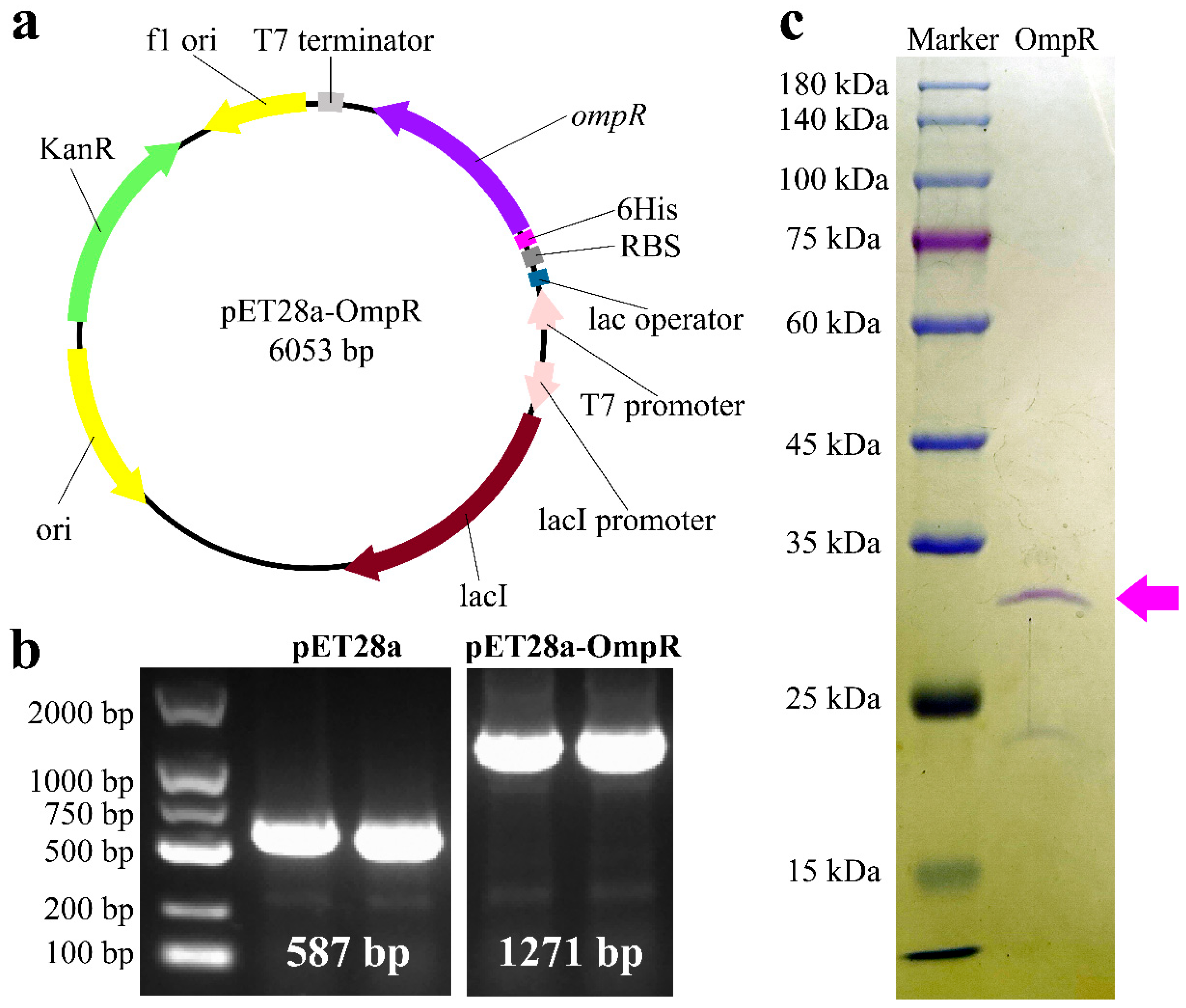
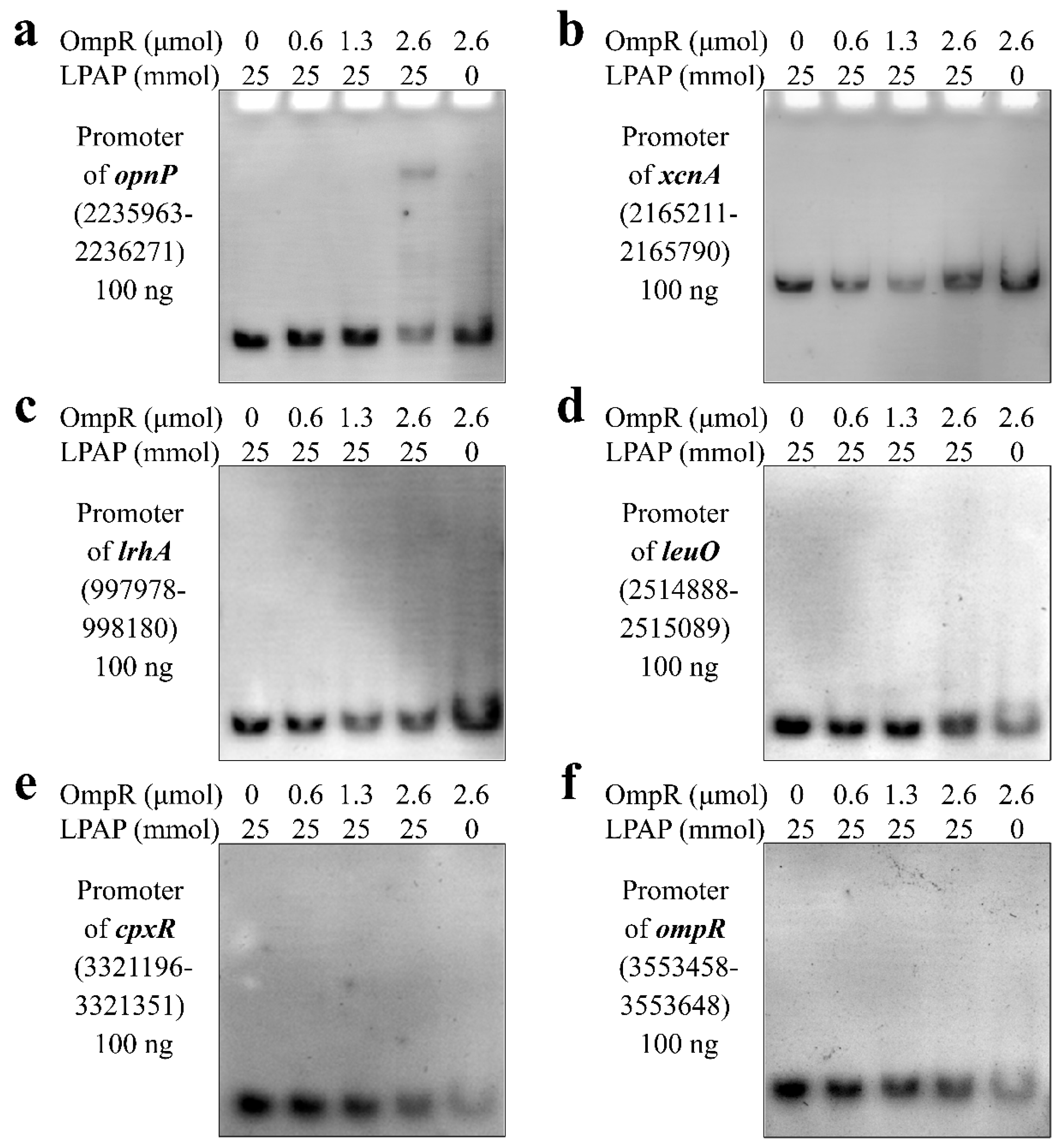
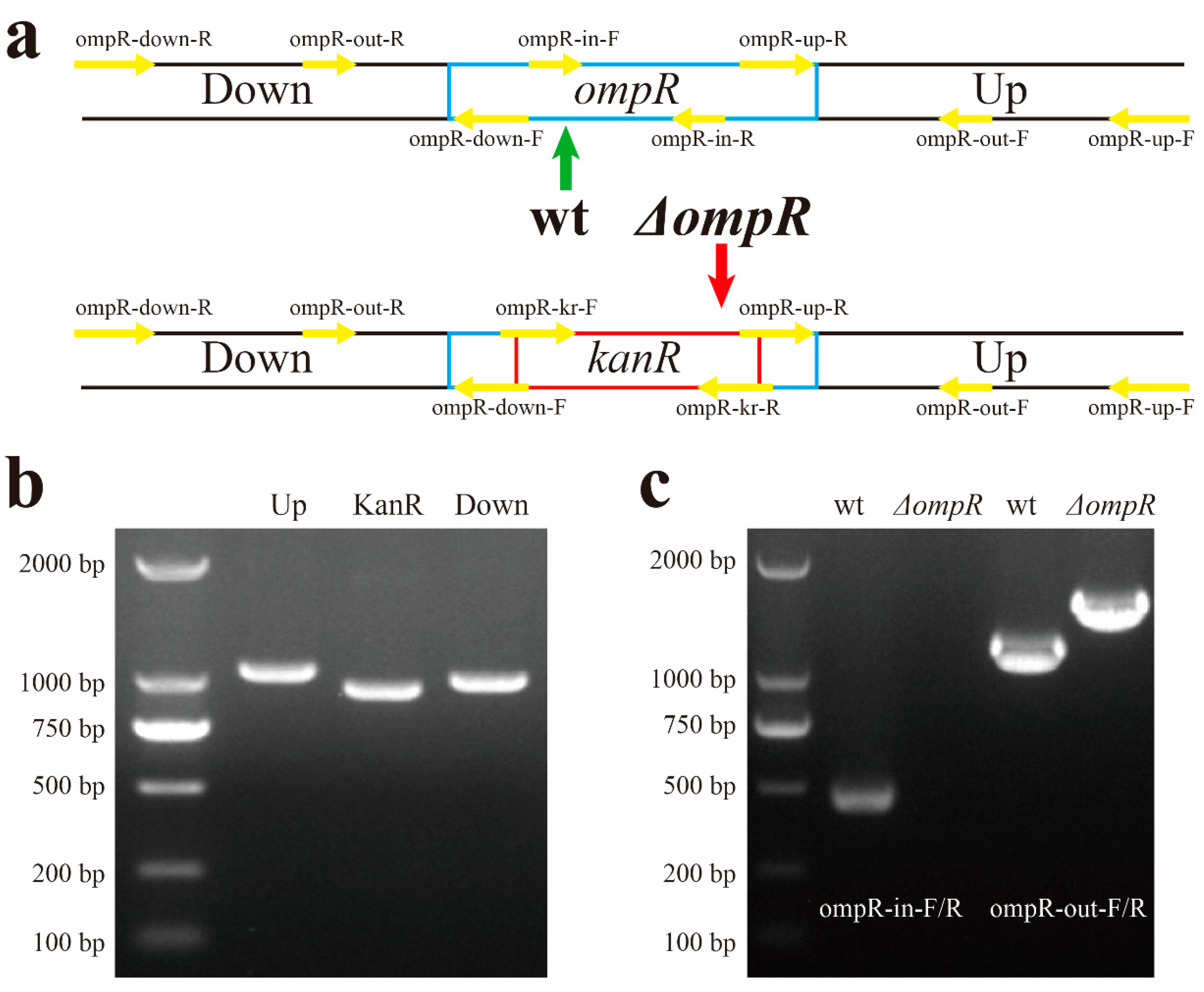
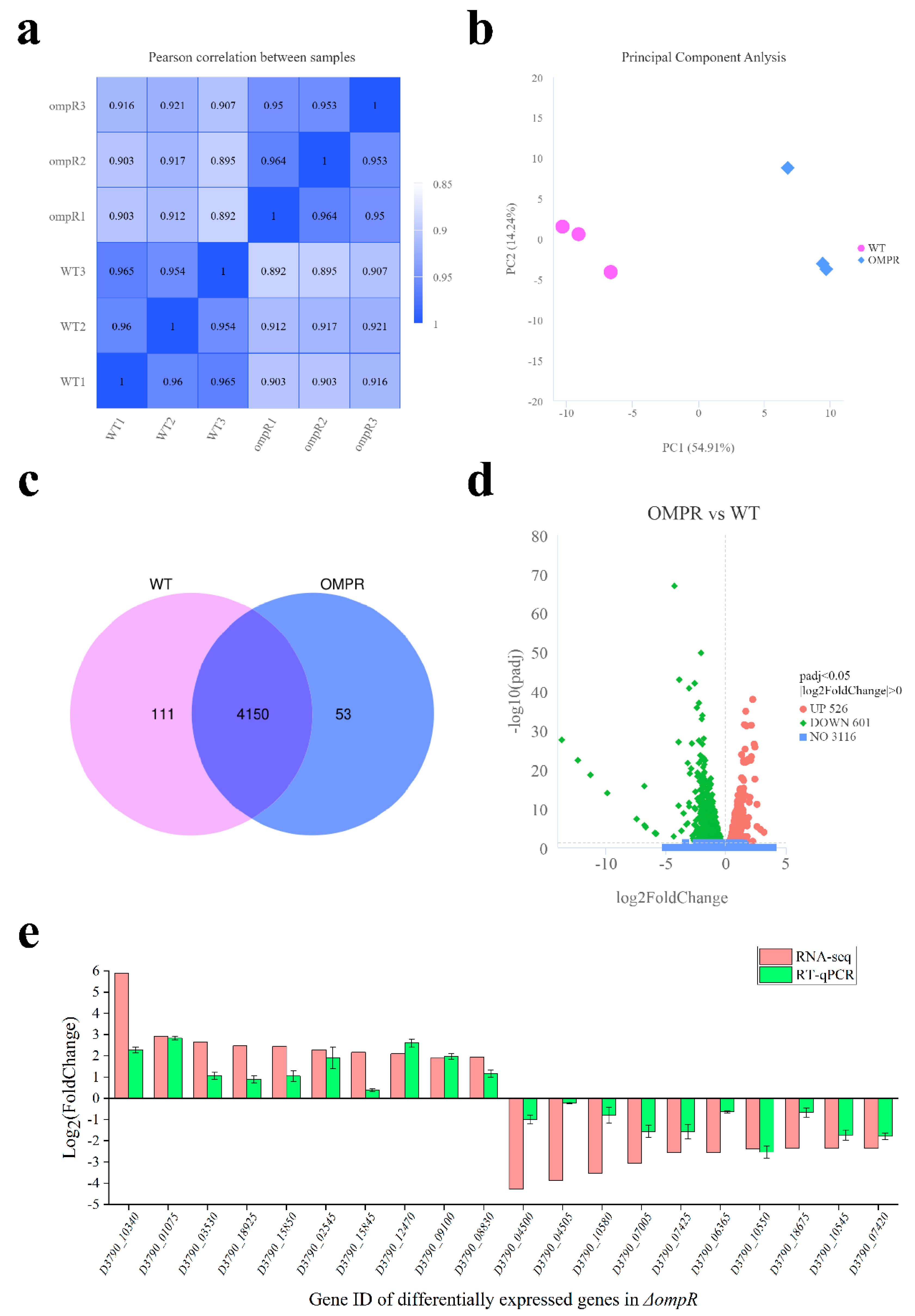
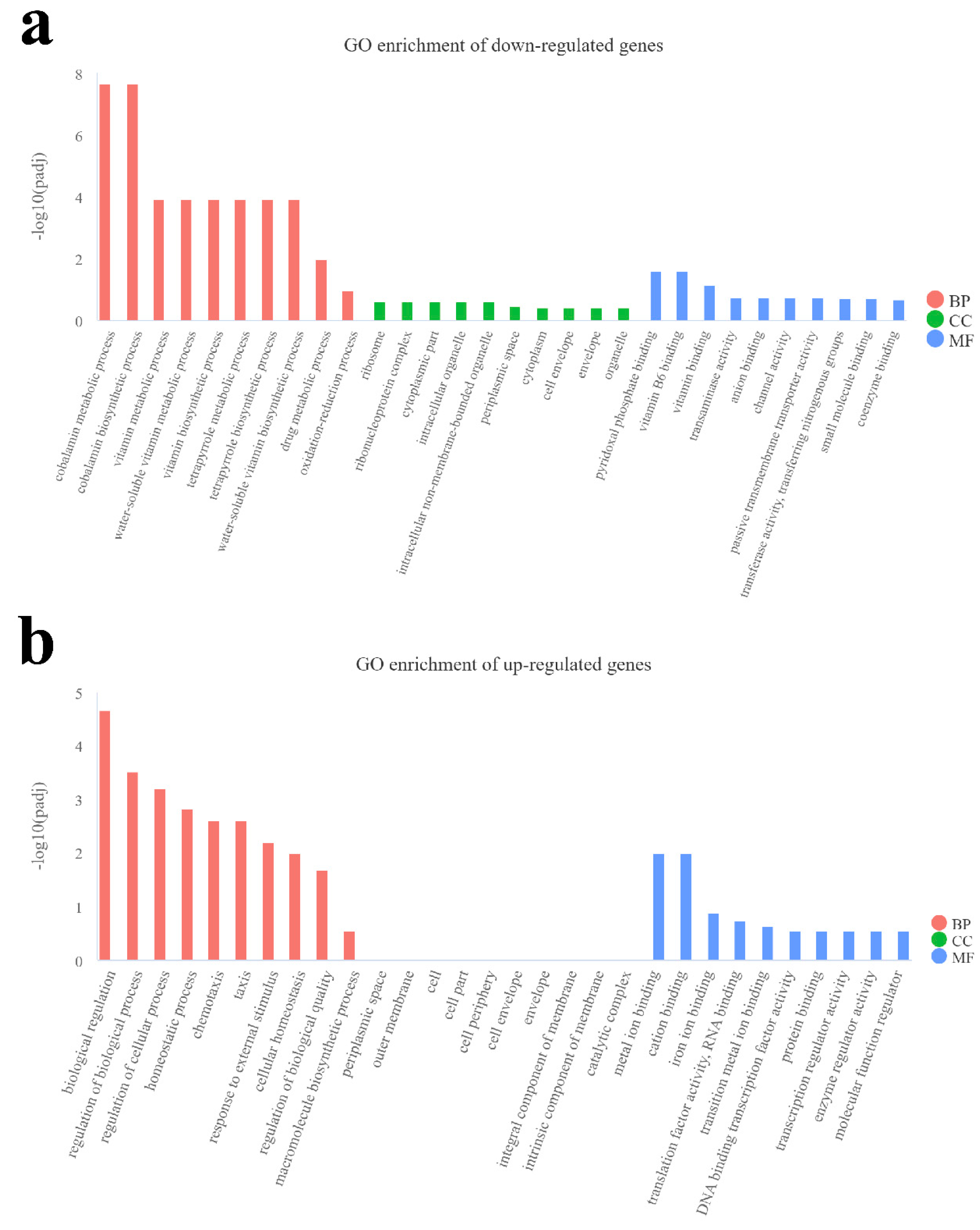

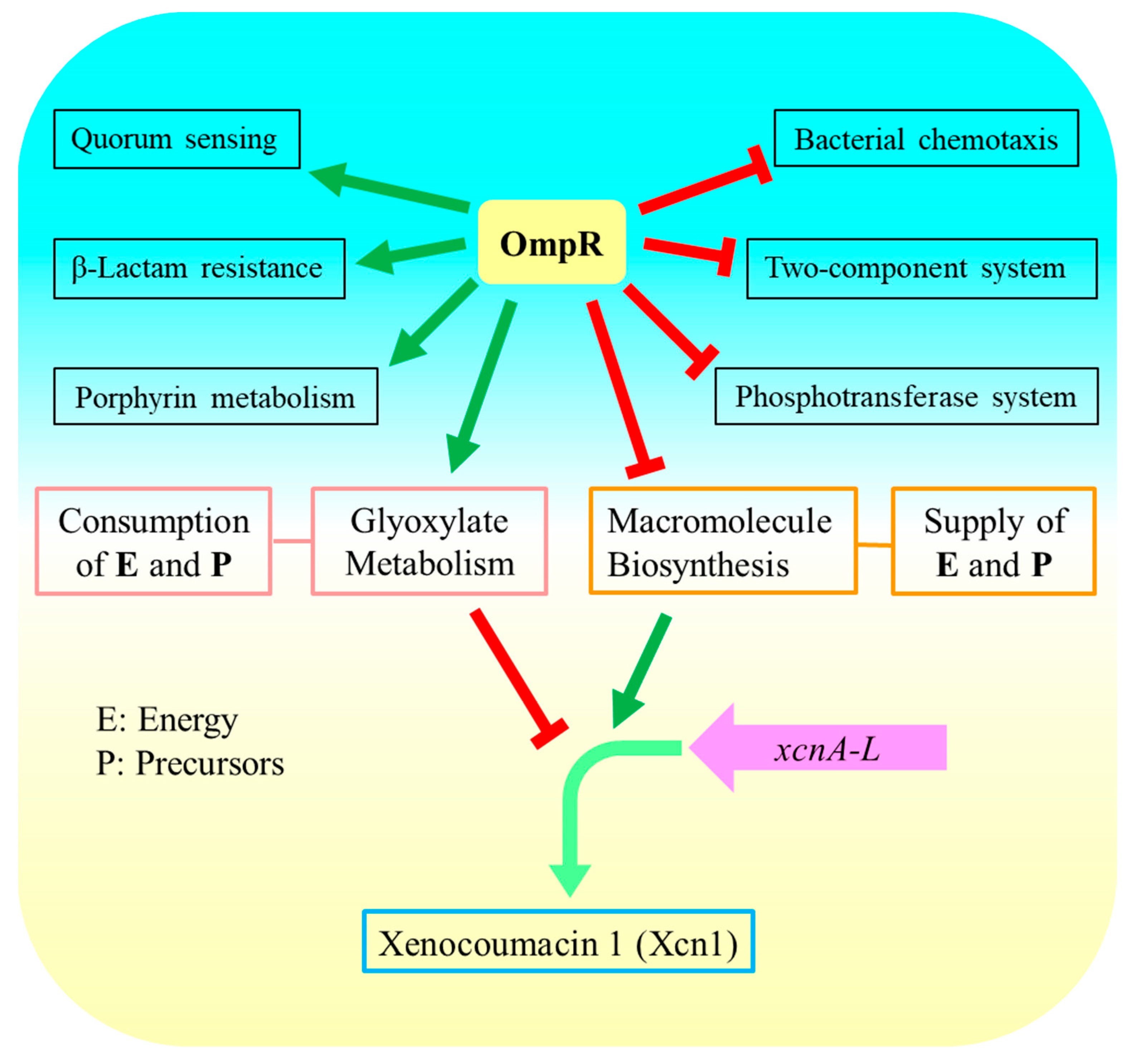
| Strains | Relevant Characteristics | Source |
|---|---|---|
| Xenorhabdus nematophila | ||
| YL001 | Wild type; Ampr | Laboratory stock |
| ΔompR | ompR of X. nematophila YL001 was replaced by Kmr | This study |
| Escherichia coli | ||
| S17-1λpir | Donor strain for conjugations | AngYuBio |
| DH5α | Strain for the reproduction of recombinant pET28a | AngYuBio |
| BL21(DE3) | Strain for protein expression | AngYuBio |
| Plasmids | ||
| pDM4 | Suicide vector; Cmr, sacB | Laboratory stock |
| pDM4-ompR-Kmr | Recombinant plasmid pDM4 for ΔompR construction | This study |
| pET28a | Source of Kmr gene; Vector for protein expression | Laboratory stock |
| pET28a-OmpR | Protein expression vector of OmpR-N6His | This study |
Disclaimer/Publisher’s Note: The statements, opinions and data contained in all publications are solely those of the individual author(s) and contributor(s) and not of MDPI and/or the editor(s). MDPI and/or the editor(s) disclaim responsibility for any injury to people or property resulting from any ideas, methods, instructions or products referred to in the content. |
© 2025 by the authors. Licensee MDPI, Basel, Switzerland. This article is an open access article distributed under the terms and conditions of the Creative Commons Attribution (CC BY) license (https://creativecommons.org/licenses/by/4.0/).
Share and Cite
Han, Y.; Zhao, X.; He, M.; Zhang, S.; Tang, G.; Wang, Y. OmpR Indirectly Regulates Biosynthesis of Xenocoumacin 1 in Xenorhabdus nematophila. Microorganisms 2025, 13, 1360. https://doi.org/10.3390/microorganisms13061360
Han Y, Zhao X, He M, Zhang S, Tang G, Wang Y. OmpR Indirectly Regulates Biosynthesis of Xenocoumacin 1 in Xenorhabdus nematophila. Microorganisms. 2025; 13(6):1360. https://doi.org/10.3390/microorganisms13061360
Chicago/Turabian StyleHan, Yunfei, Xintong Zhao, Mengru He, Shujing Zhang, Gaijuan Tang, and Yonghong Wang. 2025. "OmpR Indirectly Regulates Biosynthesis of Xenocoumacin 1 in Xenorhabdus nematophila" Microorganisms 13, no. 6: 1360. https://doi.org/10.3390/microorganisms13061360
APA StyleHan, Y., Zhao, X., He, M., Zhang, S., Tang, G., & Wang, Y. (2025). OmpR Indirectly Regulates Biosynthesis of Xenocoumacin 1 in Xenorhabdus nematophila. Microorganisms, 13(6), 1360. https://doi.org/10.3390/microorganisms13061360







